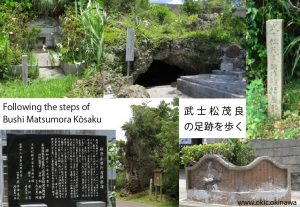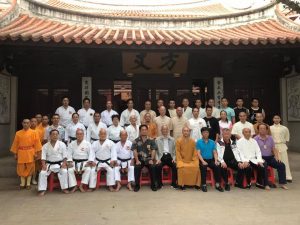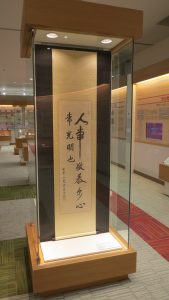As a mean to identify standard kata and to study about kata tolerance for the First international tournament of 2018, the executive committee has recorded a total of 133 video of karate kata, 28 bōjutsu kata and 17 of saijutsu kata.
They illustrate the list of kata officially chosen for this August competition.
While there are of course many more kata and versions practiced in Okinawa, it is a great way to study Okinawa karate and for first time visitors to Okinawa, to research which system appeals to one best.
Kata of Shuri – Tomarite and the various forms
- Pin-an Shōdan
- Pin-an Nidan
- Pin-an Sandan
- Pin-an Yondan
- Pin-an Godan
- Naihanchi Shōdan
- Naihanchi Nidan
- Naihanchi Sandan
- Ānankū
- Sēsan
- Wankan
- Wansū (Wanshū)
- Rōhai
- Passai
- Passai Dai (Matsumura no Passai)
- Passai Shō (Itosu no Passai)
- Chintī
- Jittī (Jitte)
- Sōchin
- Jion
- Unsū
- Gōjūshihō (ūsēshī)
- Chintō
- Kūsankū
- Kūsankū Dai
- Kūsankū Shō
Kata of Nahate and the various forms
- Gekisai Ichi (Ⅰ)
- Gekisai Ni (Ⅱ)
- Saifā
- Seyunchin (Seenchin)
- Shisōchin
- Sansērū
- Sēpai
- Kururunfā
- Sēsan
- Sūpārinpē (pecchūrin)
Kata of Uechi-ryū
Kobudō (Bō) kata and the various forms
- Ufugushiku nu Kun
- Choun nu Kun
- Shūshi nu Kun
- Shūshi nu Kun Shō
- Shūshi nu Kun Dai
- Sakugawa nu Kun
- Sakugawa nu Kun Shō
- Sakugawa nu Kun Dai
- Tokumine nu Kun
- Chikin nu Kun
- Shīshi nu Kun
- Yonegawa nu Kun
- Chinen Shikiyanaka nu Kun
- Shirotaru nu Kun
- Shiromatsu nu Kun
- Shirotaro nu Kun
- Ufutun Bō
- Kasshin Bō
The kata “Kubo nu Kun”, “Kātin nu Kun” and “Uehara nu Kun” are also listed on the official rule book.
Kobudō (Sai) kata and the various forms
- Chikin Shitahaku Nu Sai
- Chatan Yara nu Sai
- Hamahiga nu Sai
- Tawata nu Sai
- Kugushiku nu Sai
- Yakā nu Sai
- Sai I
- Sai II
- Sai III
- Ishikawagwa nu Sai
- Nichō Sai
- Sanchō Sai
- Shinbaru nu Sai
Notes:
- The names of kata, particularly for kobudō, have been written according to a tournament rule book handed during a referee meeting held on February 4th, 2018.
- Tanren-gata like Naihanchi and Sanchin are not eligible for the tournament thus not listed.
During the Ryūkyū Kingdom, Tomari was a port city involved with the foreign trade of the Shuri court. It was the entrance for foreign visitors and the culture they brought. Along the way, the area became the birthplace of many experts in the fields of Chinese classics, performing arts, music, martial arts among others.
It is said that Tomari’s temple Seigenji, commonly known as Ameku’s temple, was the base of activities of foreigners who disembarked in Tomari port. Among these were drifted ashore Chinese and Korean merchants. Tomari people were instructed in martial arts by these foreigners, which later gave birth to Tomarite, a martial art differing from the martial arts of Shuri and Naha.
Tomarite is said to have started with Teruya Kishin (1804-1864) and Uku Karyū (1800-1850). The one who inherited their art was Matsumora Kōsaku (1829-1898). He is considered as the one who rejuvenated Tomarite.
Today, there are at least 6 sites in the Okinawa prefecture that are landmarks in regard to the Tomari master’s legacy.
The most famous is indeed the praising monument located in the Shinyashiki Park. Raised in May 1983, it is located between Route 58 and the Tomari international cemetery.
Close-by, near the Tomari temple of Seigenji is the Kāmi-nu-yā cave where Matsumora Kōsaku is said to have train with a man who lived there.
A passage about this cave can be found in the 1970 published book "Karate (Tomarite) Chukō no So, Matsumora Kōsaku Ryakuden" (1) by Matsumura Kōshō. Previously named Matsumora, the author is the grandchild of Matsumora Kōsaku.
It is said that after receiving instruction in karate from Uku Karyū and Teruya Kishin, “Kōsaku went to ask for karate instruction to a Chinese who lived in a cave called ‘Kāmi-nu-yā’ on the shore of Tomari (although according to another version, it was a Ryūkyū man who hid from the royal government and thus dressed as a Chinese; anyway, the truth is unknown). At first, his request was refused but due to Kōsaku’s ardent desire, he received instruction…”
The third monument in Naha is located close by the Tomari elementary school and is known as the Bushi Matsumora relief sculpture.
Next to these three monuments and sites, there are 3 other sites that relates to the master.
One of them is the Fērē rock in Onna Village where Matsumora subdued some bandits.
A second one mentioned on the monument raised in Shinyashiki Park and in Matsumura’s book is the master’s retreat in northern Okinawa. Finally, Matsumora’s tomb is located in Onna Village.
Mainly remembered as a martial expert, Matsumora Kōsaku actually personifies a true Okinawan Bushi, meaning that next to having acquired great martial skills, he also contributed to the society. An example of his contribution is inscribed on the monument as follow.
“In the past in Tomari Village, in addition to community property received from the Ryūkyū royal administration, existed a common property called ‘Nēwagumuchi’. It was donated for the welfare of Tomari villagers by Yamazato Chōken, who passed the royal government examination and became a government official (2).
When came the abolition of feudal domains and establishment of Okinawa Prefecture in 1879, Japanese government officials planned a policy to pull up this fortune. However, at the risk of his life, the bujin of Tomari Matsumora Kōsaku demonstrated his strong spirit and the project was abandoned. Today still, the donation is utilized as funding for the Tomari Senkaku Kenshōkai, the Tomari Pioneers Praising Association. We hand to posterity the name of the fist saint Matsumora, a man who persisted in the path of crushing evil and spreading the true.”
(1) The title could be translated as “Short biography of the rejuvenator of Tomarite Karate, Matsumora Kōsaku”.
(2) Born in a poor family, Yamazato Chōken (1820-1893) raised to become a royal clerk. It is said that after passing the royal examination, he gave a huge sum of money to Tomari that was to be used for the education of local nobles.
Sources: Karatedō and kobudō preliminary survey report, Okinawa Prefecture Board of Education, Matsumura Kōkatsu’ s "Bushi Matsumora Kōsaku Ryakuden" (published in 1970)
In September 1997, the Okinawa Prefecture and the Chinese Fujian Province concluded a sister Prefecture Province treaty. To commemorate the 20th anniversary of this conclusion, the Okinawa Prefecture sent a delegation of 73 people among which many karate masters led by the Okinawa Governor. They were in China Fujian and other places from November 9 to 13 for a series of visits an receptions. (Above photo)
In Naha City's Matsuyama Park stand the Higaonna and Miyagi Monument and the Kume Village Birthplace Monument (above photo) which was erected to commemorate. Also, next to Fukushu Park is Kuninda Terrace, a facility that introduces the history of Kume formely called Kuninda. The terrace has created a map of important sites to visit in the area that we are releasing with the Kuninda Terrace’s approval.
If you are a practitioner of Gōjū-ryū or Nahate related styles, don’t miss to visit the terrace and the area.
In the Archives of the Okinawa Karate Kaikan is exhibited a brushwork once calligraphed by late Matsumura Sōkon, the great karate master.
The sentence composed of 10 characters was once introduced in Miyagi Tokumasa’s book “Karate No Rekishi” published in 1987 by Okinawa Bunko. The piece exhibited in the Archives is a replica of the original.
It seems that this phrase was taken from the “Zhuzi yulei”, a collection of conversations relating to neo-Confucian scholar Zhu Xi.
In his book, Miyagi Tokumasa wrote “Bushi Matsumura is known as a Bujin who also excelled in Bunbu Ryōdō, scholarship and the martial arts. The brushwork hereby appearing is a good and suitable material to prove this fact. The phrase reads as ‘Hito, tsuneni keikyō nareba, sunawachi kokoro wa tsuneni kōmyō nari’ (1). It was written by Sōkon when he was 76 years old of age. From the strength of the brush work and the phrases, it is indeed the artwork of a Bujin.”
In this splendid calligraphy by Matsumura Sōkon who adopted the calligrapher name “Unyū” and was also called “Buchō” the head of martial arts, the second character on the right from top reading “常 - Tsune” or always is particularly beautifully written. The viewer can easily imagine a revolving sai, the trident of kobudō or an ornamental hairpin called jīfā in Okinawa.
Do not miss to visit the Okinawa Karate Kaikan to admire the calligraphy of Matsumura Sōkon, a man who is considered as one of the “Chūkō no so (2)” of karate.
(1) One translation could be: If one is always respectful, that is the heart will always be bright.
(2) Chūkō no so: There are 3 masters considered as the rejuvenators of karate: Matsumura Sōkon (Shurite), Matsumora Kōsaku (Tomarite) and Higaonna Kanryō (Nahate).
Photo credit: Okinawa Prefecture Karate Promotion Division – Okinawa Karate Kaikan
In 1925, karate was performed in front of Prince Chichibu. However, karate was not the only martial art performed on this day. Here is a new article about Maekawa bō, and a cave that used to be a training site...




